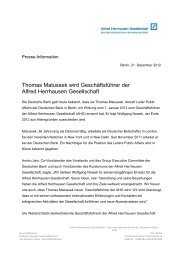Charting new directions: - Alfred Herrhausen Gesellschaft
Charting new directions: - Alfred Herrhausen Gesellschaft
Charting new directions: - Alfred Herrhausen Gesellschaft
You also want an ePaper? Increase the reach of your titles
YUMPU automatically turns print PDFs into web optimized ePapers that Google loves.
<strong>Charting</strong> <strong>new</strong> <strong>directions</strong>: Brazil’s role in a multi-polar world 19in terms of GDP, provided that the country maintainsan average annual growth rate of 5.5% for GDP, 10%for investment, and 4.5% for consumption. 2 In turn,the relatively slower growth in overall consumptionis consistent with an average expansion of fivepercent in private consumption and three percentin government consumption. 3 Considering theexpected growth in Brazilian population, an averageannual growth rate of five percent in consumptionmeans a cumulated increase of 18% in per capitaconsumption in just four years.Financial developmentIn addition to macroeconomic consistency, theexpansion in Brazil’s investment ratio also dependson financial development. In the past eight yearsmost of the domestic funding in investment hasbeen supplied by the federal government through itsdevelopment bank, the BNDES. Since this source offinance has a high fiscal cost because of Brazil’s highreal interest rate, it is necessary to develop privatesources of finance in domestic currency whilereducing the economy’s interest rate. This challengewould require three parallel actions.First, maintain fiscal and monetary stability, withrealistic inflation targets, to continue to reduceBrazil’s real interest rate. The obvious trade-off hereis that a fast reduction in inflation targets means aslow reduction in real interest rates and vice versa.Second, change financial regulation to adaptthe economy to a low inflation and low interestrate context, in particular by reducing interest-rateindexation in public debt and eliminating institutionalfloors to market interest rates. Here, the main tradeoffis between the long term gains of changing theterm and index structure of public debt and the shortrun cost of doing it.Third, improve financial supervision and regulationto expand long term finance for investment in fixedcapital and housing, while preventing speculativebubbles. The obvious trade-off here is between fastercredit expansion and stronger supervision.Commodities and manufacturing:finding a balanceBrazil has been a strong commodity-exportingeconomy throughout its history. Its abundant naturalresources give it natural advantages in the productionof agricultural and mineral commodities, whereas the<strong>new</strong>ly discovered oil reserves indicate commodityexports may become even more significant in thenear future. Despite this background in primaryproducts, Brazil has also been able to develop a largeand diversified industrial structure since the mid 20thcentury.The main reasons for this industrial developmentwere a set of nationalistic government policies andprogrammes dating back to the 1950s and, moreimportantly, the size of the Brazilian domesticmarket. In contrast to other commodity exportingeconomies, the size and scale of Brazil’s domesticmarket makes it possible for the country to buildcompetitive advantages through temporaryprograms of industrial or productive development.The key to success in this area is to devise a setof transparent policy instruments that is capable ofstimulating investment, research and development,while avoiding the creation or permanent protectionof inefficient production. In line with Rodrik’s analysisof industrial policy, it is more important to drop thelosers when that condition becomes clear than topick the winners when one does not know who theymight be. 4In the specific case of Brazil the challenge for thecoming years is use the extraordinary “profits” fromcommodity production, especially oil, to financeand stimulate the development and diversificationof the rest of the economy. The activities to be2 The “starting” conditions are an investment-ratio of 19% of GDP and a trade deficit in goods and services of one percent of GDP on 2010.3 To put these numbers in historical perspective, the average growth rate of private and government consumption in 2003-10 was 3.6% and 4.3%,respectively.4 See, Rodrik, D. (2010), “The Return of Industrial Policy”, available at: http://www.project-syndicate.org/commentary/rodrik42/English.Building Brazil’s economic future | Nelson Barbosa








